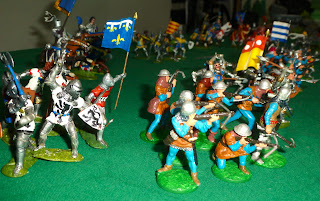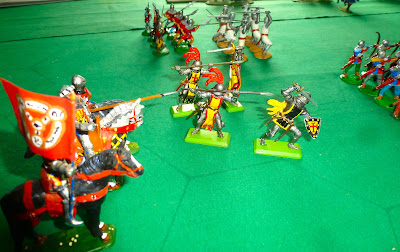Our first trial game of Lionheart worked very well so we decided to expand on it by introducing some terrain elements and and an additional two unit types; Heavy Foot Knights and Mercenaries. The remainder of the armies were the same as in our previous game and we increased the number of actions in each turn from four to six per side. The basic game mechanics were explained in my previous post HERE.
The French line up with Heavy Foot Knights on the left flank (just visible at the top of the pic) and the Kievan Mercenaries on the extreme right. For the Mercenaries we used Medieval Russian Knights made in china by Supreme along with some made in Russia by Engineer Basevitch.
While the English line advances with Heavy Foot to the front (Britains Deetail knights just beyond the Timpo Crusaders) and Irish Mercenaries with their priest following in support.
The game allows for one more unit type; Peasants, but I didn't have any suitable figures to hand so we left them out, maybe they'll appear next time.
With their enhanced mobility it's always difficult to hold back the Mounted Knights, they charge across the field when they see an opportunity to strike. This invariably draws out their opposite counterparts and leads to a duel between the chivalry.
The Mercenaries are strong in combat and have the ability to induce panic in any unit they attack, forcing them to retire, the danger is that they can be turned if they come in contact with the enemy King and may change sides.
The terrain comprised a line of hills with a road running through them on one flank, a central plain and a forest with a road running through it on the opposite flank. I like to keep things simple to begin with.
The Heavy Foot Knights (centre) are powerful in combat but very slow moving, it takes two actions to move them one hex, as a result they never really got into the game.
After the Mounted Knights had exhausted themselves duelling the Infantry and Archers moved in, the latter being quite vulnerable if attacked so need close support.
The Kings and their retinues tends to become a mounted reserve, kept safely out of the way behind the lines until desperation draws them out into the fray.
As things turned out all of the action took place in the central plain and virtually no use was made of the hills or forest. (Note to self: put more obstacles in the centre of the field next time)
I always pick up bits and pieces of Timpo medievals when I see them in the cheap junk boxes at shows, they invariably have no weapons, scabbards or shields but that's easily sorted. They are notoriously unstable on their small green bases so I mount them on 2p coins, this will be anathema to some people but lets face it they're not rare, you can find hundreds of them on the internet auction sites every day of the week.
This time the game was much less cohesive with small groups of opposing units engaging in clumps of combat dispersed around the field.
It's a good game system and I like the way it flows, I think we will need to give more thought to how we deploy the Heavy Foot Knights or revisit the way we allocate actions in each turn.
With a little tweaking the system could be easily adapted to the Dark Ages or brought forward into the Renaissance, so we might have a go at one of those periods sometime.

















































